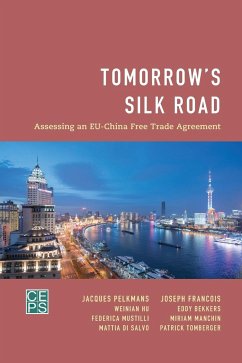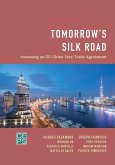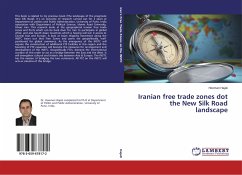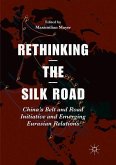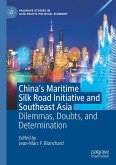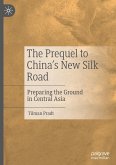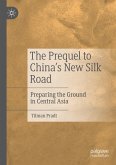- Gebundenes Buch
- Merkliste
- Auf die Merkliste
- Bewerten Bewerten
- Teilen
- Produkt teilen
- Produkterinnerung
- Produkterinnerung
The first comprehensive and in-depth economic and regulatory analysis of a possible Free Trade Area (FTA) between China and the EU.
Andere Kunden interessierten sich auch für
![Tomorrow's Silk Road Tomorrow's Silk Road]() Jacques PelkmansTomorrow's Silk Road58,99 €
Jacques PelkmansTomorrow's Silk Road58,99 €![Iranian free trade zones dot the New Silk Road landscape Iranian free trade zones dot the New Silk Road landscape]() Hooman HajatiIranian free trade zones dot the New Silk Road landscape36,99 €
Hooman HajatiIranian free trade zones dot the New Silk Road landscape36,99 €![Rethinking the Silk Road Rethinking the Silk Road]() Rethinking the Silk Road68,99 €
Rethinking the Silk Road68,99 €![China's Maritime Silk Road Initiative and Southeast Asia China's Maritime Silk Road Initiative and Southeast Asia]() China's Maritime Silk Road Initiative and Southeast Asia113,99 €
China's Maritime Silk Road Initiative and Southeast Asia113,99 €![The Prequel to China's New Silk Road The Prequel to China's New Silk Road]() Tilman PradtThe Prequel to China's New Silk Road38,99 €
Tilman PradtThe Prequel to China's New Silk Road38,99 €![The Prequel to China's New Silk Road The Prequel to China's New Silk Road]() Tilman PradtThe Prequel to China's New Silk Road38,99 €
Tilman PradtThe Prequel to China's New Silk Road38,99 €![Global Political Economy Global Political Economy]() Bill DunnGlobal Political Economy40,99 €
Bill DunnGlobal Political Economy40,99 €-
-
-
The first comprehensive and in-depth economic and regulatory analysis of a possible Free Trade Area (FTA) between China and the EU.
Produktdetails
- Produktdetails
- Verlag: Center for European Policy Studies
- Seitenzahl: 332
- Erscheinungstermin: 26. Juni 2018
- Englisch
- Abmessung: 260mm x 183mm x 22mm
- Gewicht: 821g
- ISBN-13: 9781786607867
- ISBN-10: 1786607867
- Artikelnr.: 52643350
- Herstellerkennzeichnung
- Libri GmbH
- Europaallee 1
- 36244 Bad Hersfeld
- gpsr@libri.de
- Verlag: Center for European Policy Studies
- Seitenzahl: 332
- Erscheinungstermin: 26. Juni 2018
- Englisch
- Abmessung: 260mm x 183mm x 22mm
- Gewicht: 821g
- ISBN-13: 9781786607867
- ISBN-10: 1786607867
- Artikelnr.: 52643350
- Herstellerkennzeichnung
- Libri GmbH
- Europaallee 1
- 36244 Bad Hersfeld
- gpsr@libri.de
Joseph Francois is Managing Director and professor of economics at the World Trade Institute. He also serves as deputy director of the NCCR Trade Regulation. Previously he was professor of economics (with a chair in economic theory) at the Johannes Kepler Universität Linz. He is a fellow of the Centre for Economic Policy Research (London), director of the European Trade Study Group and the Institute for International and Development Economics, senior research fellow with the Vienna Institute for International Economic Studies, and a board member of the Global Trade Analysis Project. He serves on the editorial board of the Review of Development Economics, and the World Trade Review.
Executive Summary
Introduction
Part I: The Global and Bilateral Context
1. Why an EU-China free trade area?
2. China and the EU in a rapidly changing world economy
3. Bilateral economic relations: Trade and investments
4. Global value chains: Significance for the EU and China
Part II: Design and Substance of an EU-China FTA
5. What would an EU-China FTA look like?
6. Market access in industrial goods: An analysis of tariffs
7. Market access in goods: Trade defence remedies
8. Market access in agriculture: Tariffs and tariff-rate quotas
9. Technical barriers to trade
10. Reducing SPS barriers in an EU-China FTA
11. Market access in services: China and the EU
12. Public procurement
13. Intellectual property rights and geographical indications
14. State-owned enterprises (SOEs) and competition policy
15. Investment and the BIT
Part II:Potential Economic Impact: A CGE-based simulation of effects of the FTA
16. Introduction
17. Trade and production linkages
18. Removing tariffs and reducing NTM costs in a China-EU FTA
19. Modelling the FTA between China and the EU
Part IV: Conclusions and Policy Implications
20. Policy implications of an EU-China free trade agreement
References
Introduction
Part I: The Global and Bilateral Context
1. Why an EU-China free trade area?
2. China and the EU in a rapidly changing world economy
3. Bilateral economic relations: Trade and investments
4. Global value chains: Significance for the EU and China
Part II: Design and Substance of an EU-China FTA
5. What would an EU-China FTA look like?
6. Market access in industrial goods: An analysis of tariffs
7. Market access in goods: Trade defence remedies
8. Market access in agriculture: Tariffs and tariff-rate quotas
9. Technical barriers to trade
10. Reducing SPS barriers in an EU-China FTA
11. Market access in services: China and the EU
12. Public procurement
13. Intellectual property rights and geographical indications
14. State-owned enterprises (SOEs) and competition policy
15. Investment and the BIT
Part II:Potential Economic Impact: A CGE-based simulation of effects of the FTA
16. Introduction
17. Trade and production linkages
18. Removing tariffs and reducing NTM costs in a China-EU FTA
19. Modelling the FTA between China and the EU
Part IV: Conclusions and Policy Implications
20. Policy implications of an EU-China free trade agreement
References
Executive Summary
Introduction
Part I: The Global and Bilateral Context
1. Why an EU-China free trade area?
2. China and the EU in a rapidly changing world economy
3. Bilateral economic relations: Trade and investments
4. Global value chains: Significance for the EU and China
Part II: Design and Substance of an EU-China FTA
5. What would an EU-China FTA look like?
6. Market access in industrial goods: An analysis of tariffs
7. Market access in goods: Trade defence remedies
8. Market access in agriculture: Tariffs and tariff-rate quotas
9. Technical barriers to trade
10. Reducing SPS barriers in an EU-China FTA
11. Market access in services: China and the EU
12. Public procurement
13. Intellectual property rights and geographical indications
14. State-owned enterprises (SOEs) and competition policy
15. Investment and the BIT
Part II:Potential Economic Impact: A CGE-based simulation of effects of the FTA
16. Introduction
17. Trade and production linkages
18. Removing tariffs and reducing NTM costs in a China-EU FTA
19. Modelling the FTA between China and the EU
Part IV: Conclusions and Policy Implications
20. Policy implications of an EU-China free trade agreement
References
Introduction
Part I: The Global and Bilateral Context
1. Why an EU-China free trade area?
2. China and the EU in a rapidly changing world economy
3. Bilateral economic relations: Trade and investments
4. Global value chains: Significance for the EU and China
Part II: Design and Substance of an EU-China FTA
5. What would an EU-China FTA look like?
6. Market access in industrial goods: An analysis of tariffs
7. Market access in goods: Trade defence remedies
8. Market access in agriculture: Tariffs and tariff-rate quotas
9. Technical barriers to trade
10. Reducing SPS barriers in an EU-China FTA
11. Market access in services: China and the EU
12. Public procurement
13. Intellectual property rights and geographical indications
14. State-owned enterprises (SOEs) and competition policy
15. Investment and the BIT
Part II:Potential Economic Impact: A CGE-based simulation of effects of the FTA
16. Introduction
17. Trade and production linkages
18. Removing tariffs and reducing NTM costs in a China-EU FTA
19. Modelling the FTA between China and the EU
Part IV: Conclusions and Policy Implications
20. Policy implications of an EU-China free trade agreement
References

